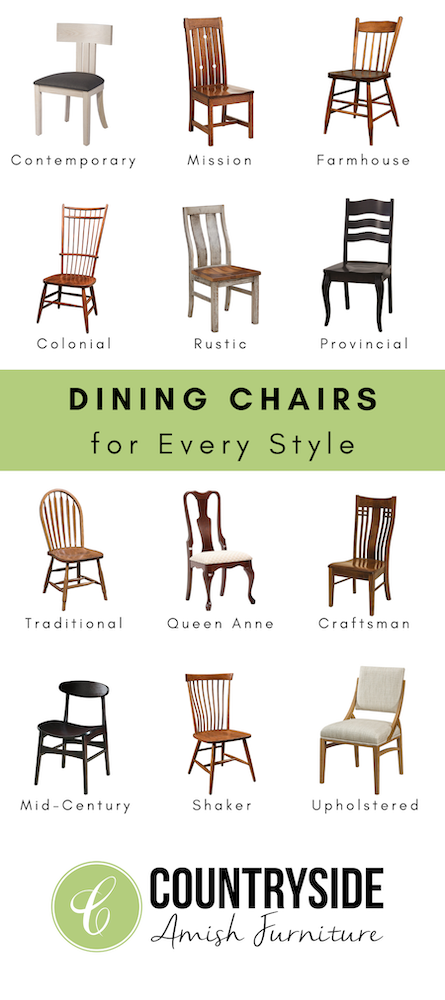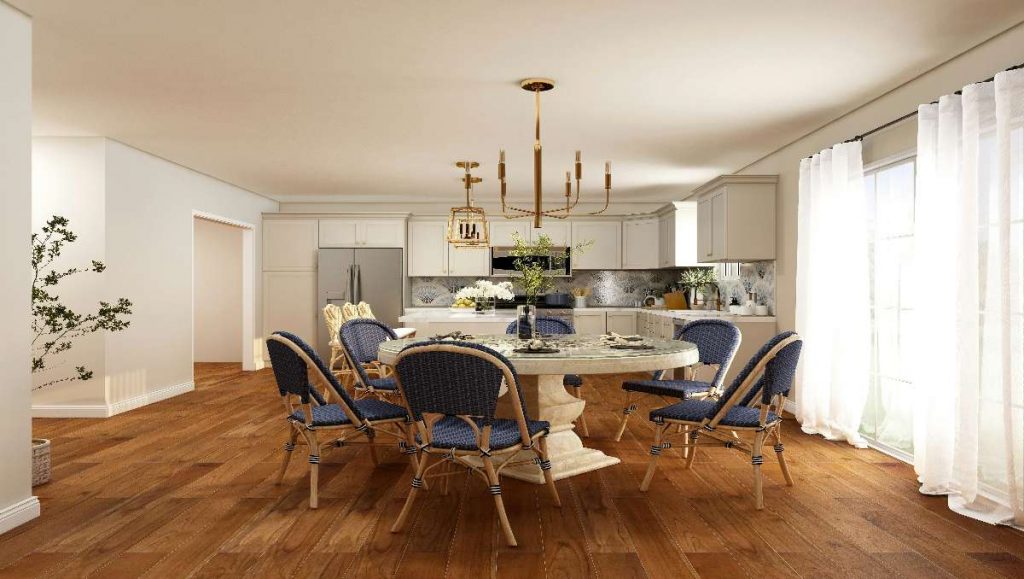
Few pieces of dining room furniture hold the power to transform a dining room quite like the dining chair. They set the stage for countless meals, conversations, and laughter, becoming an integral part of the room’s ambiance. But with a vast array of styles available, from timeless heirlooms to sleek, modern designs, choosing the right dining chair can feel overwhelming.
Key Takeaways
- Dining chairs play a crucial role in creating a comfortable and inviting dining space.
- Consider several factors when choosing dining chairs: functionality, comfort, aesthetics, budget, and durability. Ensure the chairs fit your table height, offer good back support, and suit your needs (armrests, easy movement).
- Popular dining chair styles include traditional, transitional, contemporary, and modern.
- The latest trends in dining chairs emphasize sustainability, technological innovation, and customization.
- There’s no single “right” dining chair style. Explore the vast options available to find chairs that complement your dining space and personal taste.
This guide is designed to help you navigate the exciting – and sometimes intimidating – world of dining chair styles. It will equip you with the knowledge to find the perfect chairs to complement your space and personal taste.
The Evolution of Dining Chair Styles
Dining chairs have evolved throughout history, reflecting changing styles, materials, and social customs. Understanding this evolution can enrich your selection process. The earliest known dining chairs date back to ancient Egypt and Greece, often reserved for royalty and high-ranking officials. Made from precious materials like bronze or ivory and adorned with intricate carvings, these chairs were symbols of power and status.
The Renaissance period brought a focus on classical ideals, transforming dining chair design. Chairs became more elaborate with rich fabrics, intricate carvings, and high backs for added comfort and formality. Walnut was a popular choice for its beauty and durability.
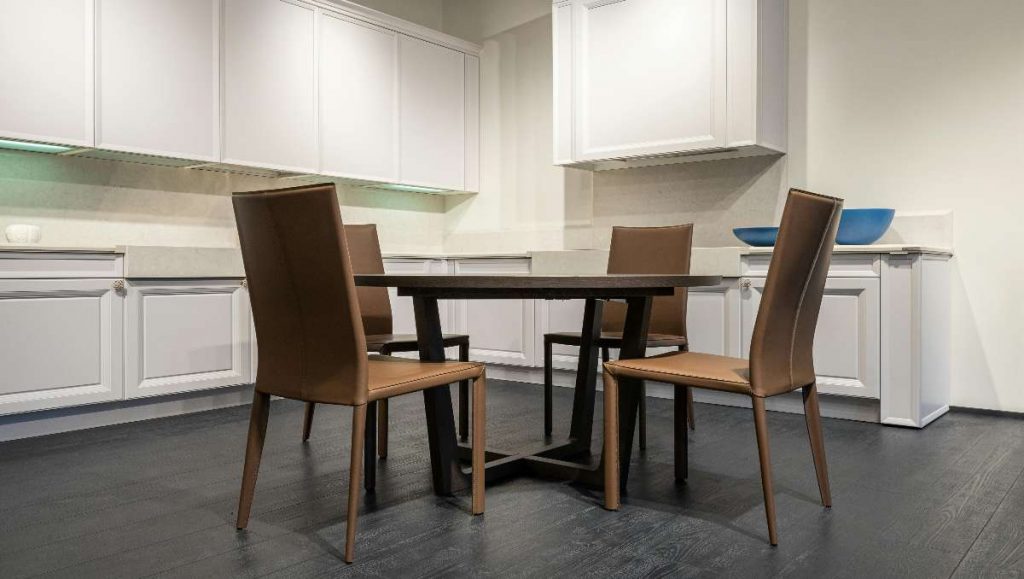
The Victorian era saw the rise of the middle class and increased demand for mass-produced furniture. Dining chairs became more ornate, featuring plush upholstery, deep button tufts, and richly stained wood. The Industrial Revolution introduced new materials like steel and cast iron, making chairs more durable and affordable. The 20th century brought a dramatic shift towards clean lines, functionality, and a focus on natural materials. Mid-century modern dining chairs are known for their sleek silhouettes, often featuring tapered legs, exposed wood grains, and pops of color. Designers like Charles and Ray Eames and Hans Wegner revolutionized dining chair design with their innovative use of materials like bent plywood and molded plastic.
Today, dining chair styles encompass a vast spectrum, drawing inspiration from all corners of history. Modern chairs continue to embrace clean lines and innovative materials like molded plastics and acrylics. However, a renewed appreciation for craftsmanship has led to a resurgence of traditional styles, often reimagined with a contemporary twist.
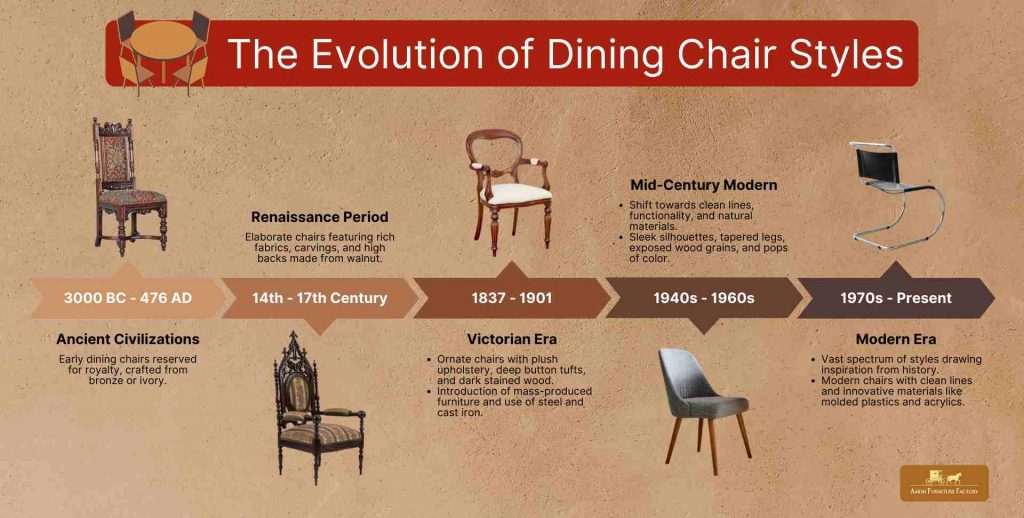
Traditional Dining Chair Styles
Traditional dining chair styles offer a sense of timeless elegance and enduring quality, perfect for creating a warm and inviting atmosphere in your dining room. These chairs are steeped in history and craftsmanship, often featuring rich wood tones, intricate details, and comfortable designs built for lingering over meals.
Here’s a closer look at some of the most popular traditional styles:
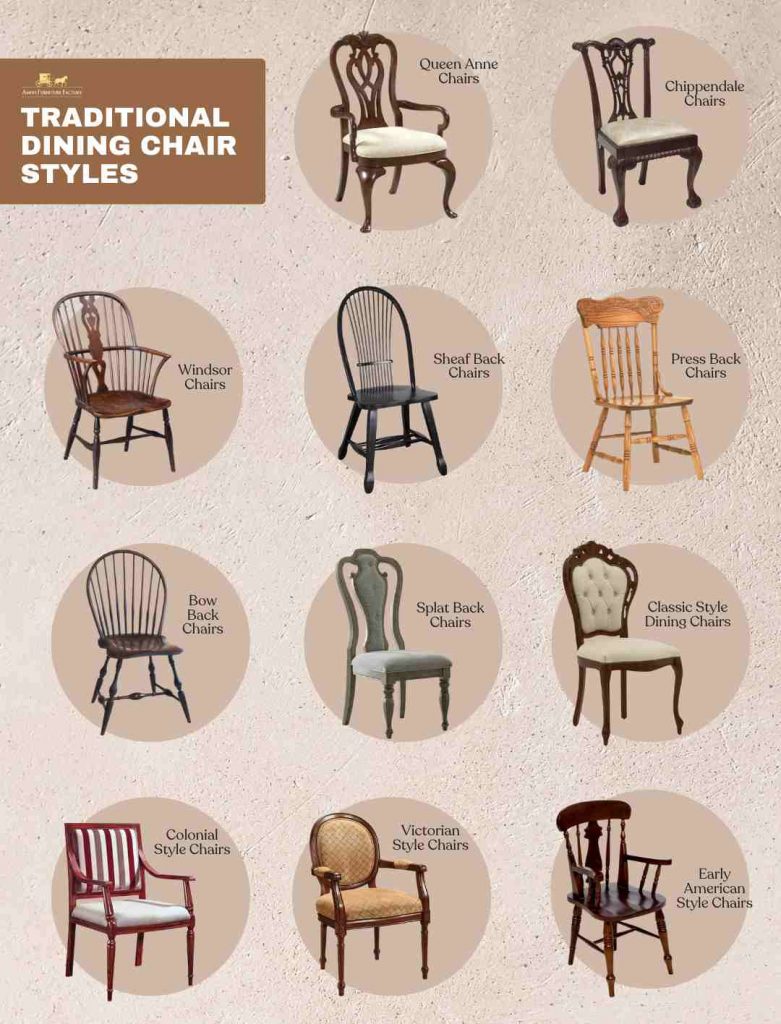
Chippendale Chairs
Known for their intricate fretwork designs on the back splats, often incorporating geometric shapes or Chinese-inspired motifs. Chippendale chairs typically have straight legs and may feature leather or fabric upholstery. They are celebrated for their elegance and the high level of craftsmanship required to produce their detailed designs.
Windsor Chairs
A hallmark of American colonial style, Windsor chairs are characterized by their simple, yet sturdy construction. They feature a spooned back with spindles (thin vertical rods) and often have a rush seat for a rustic touch. These chairs are known for their comfort and durability, making them a practical choice for everyday use.
Sheaf Back Chairs
These chairs boast a distinctive back design that resembles a bundle of wheat stalks. Sheaf back chairs are typically made from wood and may have upholstered seats for added comfort. Their unique design adds a touch of charm and rustic elegance to any dining room. The sheaf back design is symbolic of prosperity and abundance.
Press Back Chairs
Named for the decorative technique used to create their unique back splat designs, press back chairs often feature floral or geometric patterns. They are known for their simple lines and comfortable proportions, making them a versatile choice for various settings. The press back technique involves pressing a heated metal die into the wood, creating a durable impression.
Bow Back Chairs
Characterized by a gracefully curved top rail on the backrest, bow back chairs are known for their elegant silhouette. They can be simple or more ornate, depending on the design. The bow back design provides both support and a visually pleasing shape, making these chairs a popular choice for formal and informal dining rooms alike.
Splat Back Chairs
A broad category encompassing many traditional styles, splat back chairs feature a single vertical panel separating the seat from the backrest. The design of the splat can vary greatly, offering a wide range of aesthetic possibilities. These chairs often incorporate intricate carvings and are highly valued for their decorative appeal.
Classic Style Dining Chairs
This category encompasses timeless designs that draw inspiration from various historical periods. Classic style chairs like the Morris chair often feature high backs, rich wood finishes, and elegant curves, offering a sense of sophistication and tradition. They are perfect for creating a formal dining atmosphere.
Queen Anne Chairs
Recognizable by their cabriole legs (with an S-shaped curve), splat backs (a vertical panel separating the seat from the backrest), and upholstered seats for added comfort. These chairs often showcase intricate carvings and delicate, graceful lines that add a touch of sophistication to any dining space.
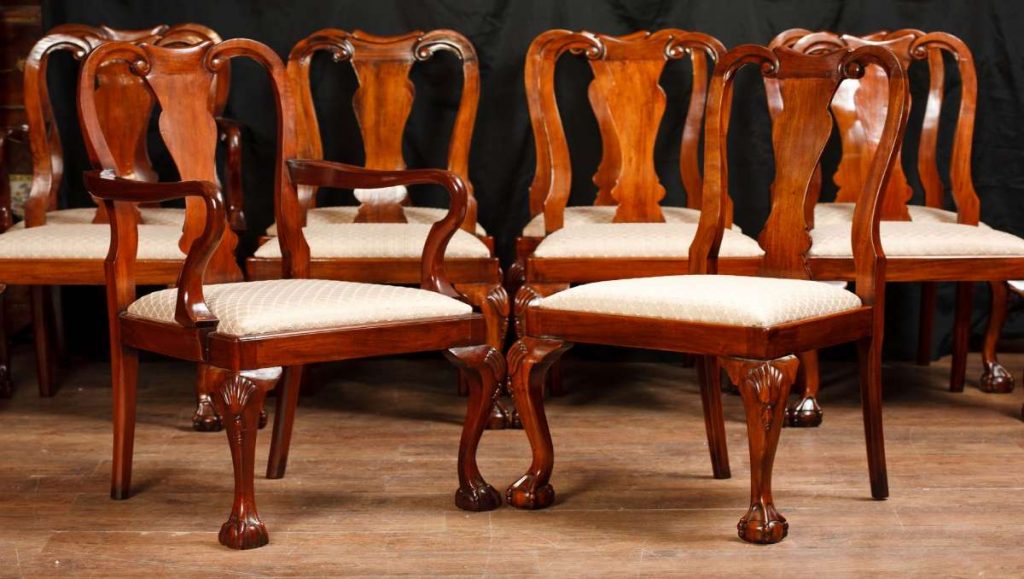
Colonial Style Chairs
Evoking the spirit of early America, colonial style chairs are known for their simple lines, sturdy construction, and use of natural materials like maple or cherry. Windsor chairs and ladderback chairs are prime examples of this style, emphasizing functionality and straightforward design. Colonial chairs often feature turned legs and spindles, giving them a handcrafted look.
Victorian Style Chairs
Reflecting the opulence of the Victorian era, Victorian style chairs tend to be more ornate than their colonial counterparts. They may feature dark stained wood, plush upholstery with deep button tufting, and intricate carvings. These chairs add a luxurious and dramatic flair to the dining room.
Early American Style Chairs
Similar to colonial style chairs, Early American chairs prioritize simplicity and functionality. They are often made from local hardwoods and feature clean lines and uncluttered designs. These chairs embody the practical and straightforward approach to furniture design that was prevalent during the early years of America.
Transitional Dining Chair Styles
Transitional dining chair styles offer the perfect blend of timeless elegance and modern functionality. They borrow elements from both traditional and contemporary design, creating a look that is both familiar and fresh.
Here’s a closer look at some popular transitional dining chair styles:
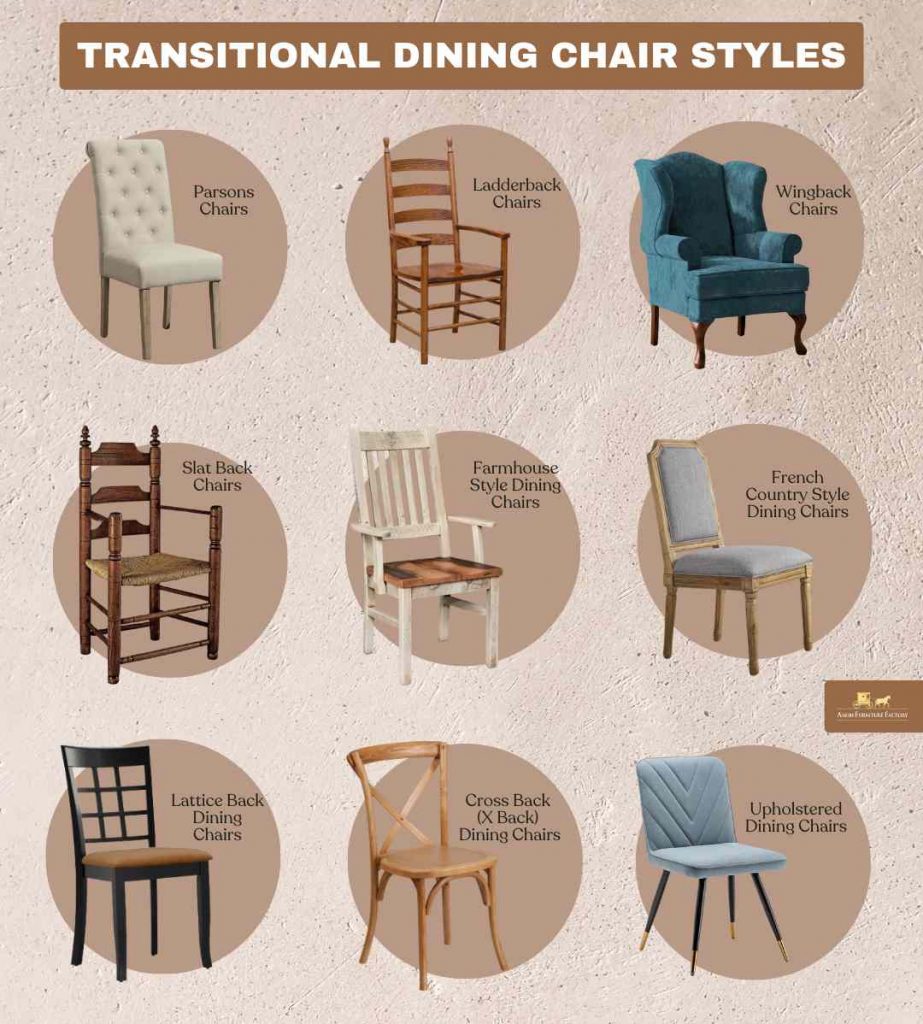
Parsons Chairs
Simple and sophisticated, Parsons chairs are a staple of transitional design. They feature clean lines, a straight back, and an upholstered seat, making them a versatile choice for any dining room. The upholstery can be neutral (think linen or beige) or a bolder color or pattern to add a pop of personality.
Wingback Chairs
Traditionally associated with formal settings, wingback chairs can be given a transitional twist with clean lines, a lighter wood finish, and a less bulky overall profile. The iconic wingback design offers a sense of comfort and enclosure, making them ideal for anchoring a dining table and creating a cozy and inviting atmosphere.
Slat Back Chairs
Similar to ladderback chairs, slat back chairs feature vertical slats on the backrest. Transitional versions tend to have a more minimalist aesthetic, with fewer and wider slats compared to traditional styles, offering a clean and airy feel. These chairs can be crafted from wood or metal, and may be upholstered for added comfort.
Farmhouse Style Dining Chairs
Evoking a sense of warmth and rustic charm, farmhouse style dining chairs often feature simple lines, natural wood finishes like reclaimed wood or distressed oak, and upholstered seats in neutral tones like beige or light gray. Transitional takes on this style may incorporate lighter wood tones, woven fabrics like natural linen or woven seagrass.
French Country Style Dining Chairs
French country chairs bring a touch of European elegance to the dining room. Transitional versions often feature curved lines, distressed finishes on the wood, and muted upholstery tones like light blue, soft green, or a muted floral pattern. Think of spindle back chairs with a slightly sleeker silhouette or upholstered chairs with a less ornate floral pattern and clean lines.
Ladderback Chairs
A classic design with a modern twist, ladderback chairs feature a series of horizontal slats on the backrest. Transitional versions often have a lighter, more streamlined silhouette compared to their more traditional counterparts, with fewer rungs and a more open feel. They can be crafted from wood or metal, and may be upholstered for added comfort and a touch of luxury.
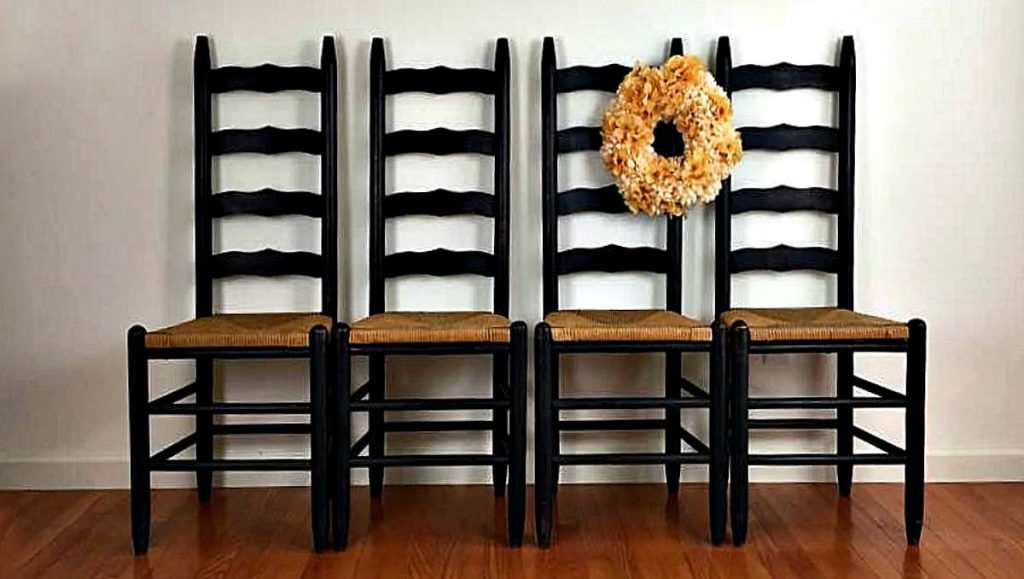
Lattice Back Dining Chairs
Lattice back chairs offer a unique and visually interesting design element. Transitional versions may feature a more geometric lattice pattern in a modern square or rectangular design, or a combination of wood and metal for a touch of modern flair. Consider chairs with a metal frame and a woven rattan back for a light and airy feel.
Cross Back (X Back) Dining Chairs
A classic design with simple elegance, cross back chairs feature an X-shaped design on the backrest. Transitional versions often have a lighter and more streamlined silhouette compared to their more traditional counterparts, with thinner slats and a less bulky overall design. They are a versatile choice that complements a variety of dining room styles.
Upholstered Dining Chairs
Upholstered dining chairs offer a touch of luxury and comfort to the dining space. Transitional options come in a wide range of fabrics and colors, allowing you to personalize the look and feel of your dining room. Look for chairs with clean lines, minimal tufting, and fabrics in neutral tones or muted colors for a more modern take on this classic style.
Contemporary Dining Chair Styles
Contemporary dining chair styles showcase a forward-thinking approach to design, prioritizing clean lines, functionality, and innovative materials. These chairs are ideal for creating a sleek and modern dining space that reflects the latest trends.
Here’s a look at some popular contemporary dining chair styles:
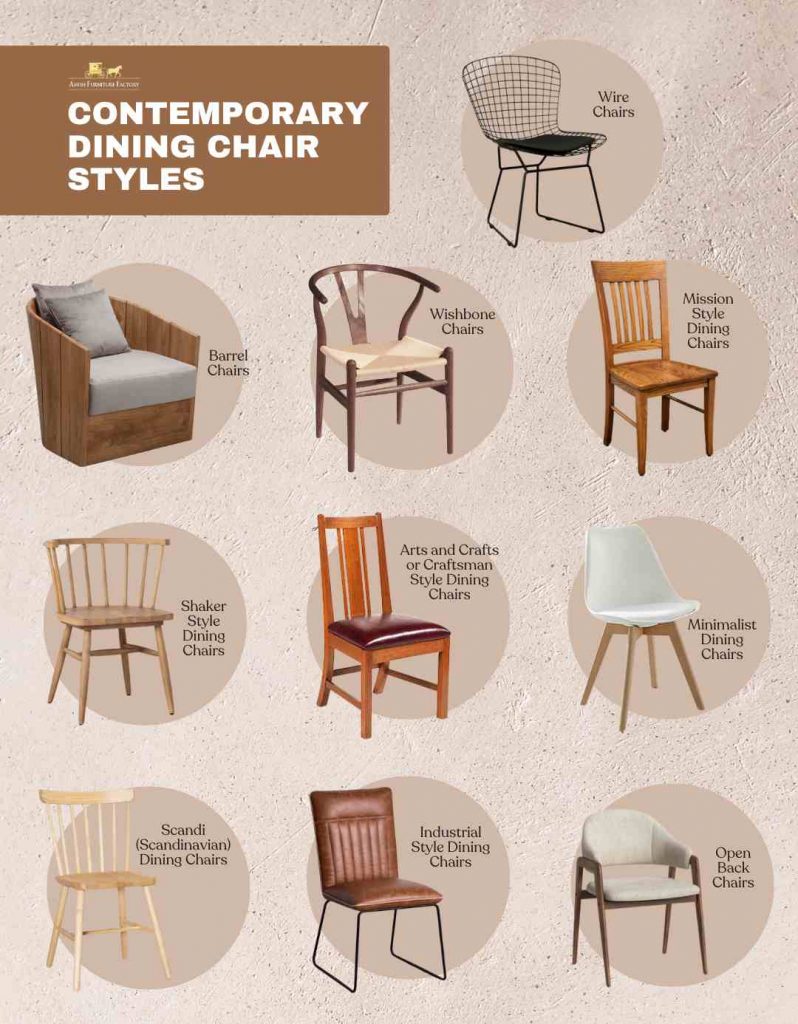
Wire Chairs
A design icon, wire chairs offer a combination of comfort and visual transparency. Pioneered by designers like Charles and Ray Eames, these chairs are typically crafted from bent metal wire and often feature a molded plastic seat for added comfort. Their lightweight design and airy aesthetic make them a popular choice for creating a light and breezy feel in any dining room.
Barrel Chairs
Offering a unique and sculptural silhouette, barrel chairs feature a curved back that wraps around the sides, creating a sense of enclosure and a touch of luxury. Contemporary versions often have a lower profile and sleeker lines compared to their mid-century modern counterparts, with tapered legs and a more streamlined design.
Wishbone Chairs
A timeless design with a modern twist, wishbone chairs feature a distinctive Y-shaped back splat. Contemporary takes on this classic style may incorporate lighter wood tones like beech or ash, a more sculptural interpretation of the wishbone design with a focus on clean lines, or even a combination of wood and metal for a touch of modern flair.
Mission Style Dining Chairs
Characterized by clean lines, simple construction, and a focus on natural materials like quarter-sawn oak or cherry, mission style dining chairs offer a nod to the Arts and Crafts movement. They often feature exposed joinery and tapered legs for a touch of craftsmanship. Contemporary versions may incorporate lighter wood tones like white oak, a sleeker silhouette with thinner legs, or even a touch of upholstery on the seat for added comfort.
Shaker Style Dining Chairs
Similar to mission style chairs, Shaker style dining chairs prioritize simplicity and functionality. They typically feature clean lines, tapered legs, and a spooned back with minimal ornamentation. Contemporary takes on this classic style may incorporate lighter wood tones or a touch of paint for a pop of color.
Arts and Crafts or Craftsman Style Dining Chairs
Drawing inspiration from the American Arts and Crafts movement, these chairs emphasize handcrafted details and natural materials like oak or maple. They often feature exposed joinery, tapered legs, and a focus on quality construction. Contemporary versions may incorporate lighter wood tones or even a touch of upholstery for added comfort.
Minimalist Dining Chairs
As the name suggests, minimalist dining chairs prioritize clean lines, a lack of ornamentation, and a focus on function. These chairs are often made from simple materials like wood, metal, or molded plastic, and come in a variety of shapes and sizes. They are ideal for creating a sleek and modern dining space that prioritizes clean lines and uncluttered aesthetics.
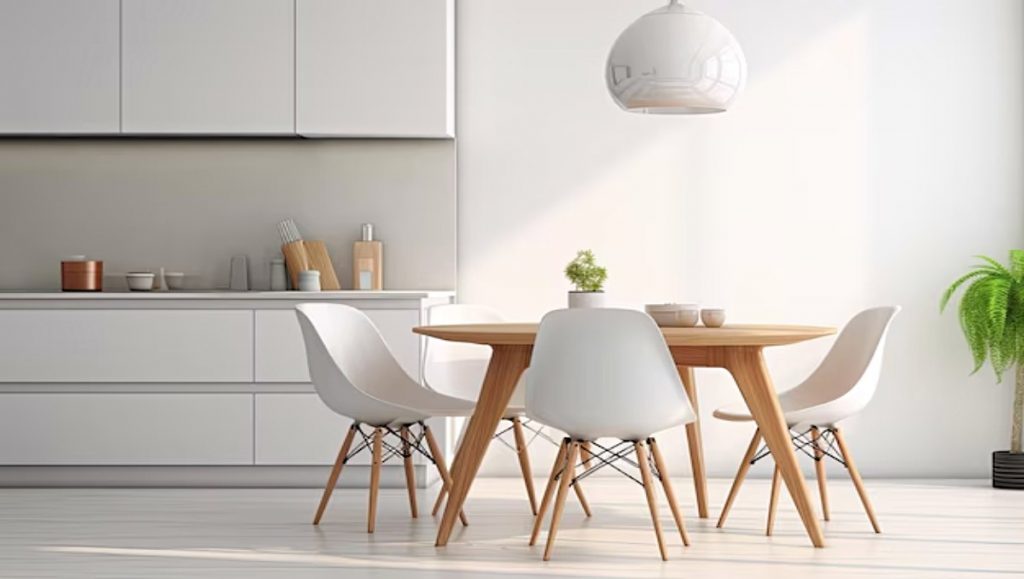
Scandi (Scandinavian) Dining Chairs
Embracing a minimalist approach with a focus on functionality and natural materials, Scandi dining chairs are a popular choice for contemporary dining spaces. Think clean lines, light wood tones like beech or ash, and comfortable yet simple silhouettes that prioritize ergonomics. These chairs often incorporate natural fabrics like wool or linen for added warmth and texture.
Industrial Style Dining Chairs
Drawing inspiration from industrial design elements, these chairs often feature exposed metal frames, distressed finishes, and leather upholstery. They offer a touch of rugged charm to the dining space and are a perfect choice for those who love a modern yet edgy aesthetic. Consider chairs with a blackened metal frame and distressed brown leather upholstery.
Open Back Chairs
Offering a lightweight and airy feel, open back chairs feature a design that eliminates the traditional solid backrest. Open back chairs are a popular choice for small spaces or for creating a more casual dining atmosphere. Consider chairs with vertical slats in a light wood tone, or a curved metal frame with a woven rattan seat for a bohemian touch.
Modern Dining Chair Styles
Modern dining chair styles embrace innovation, pushing the boundaries of form, function, and materials. These chairs are for those who love a cutting-edge aesthetic and a conversation-starting dining space.
Here’s a look at some popular modern dining chair styles:
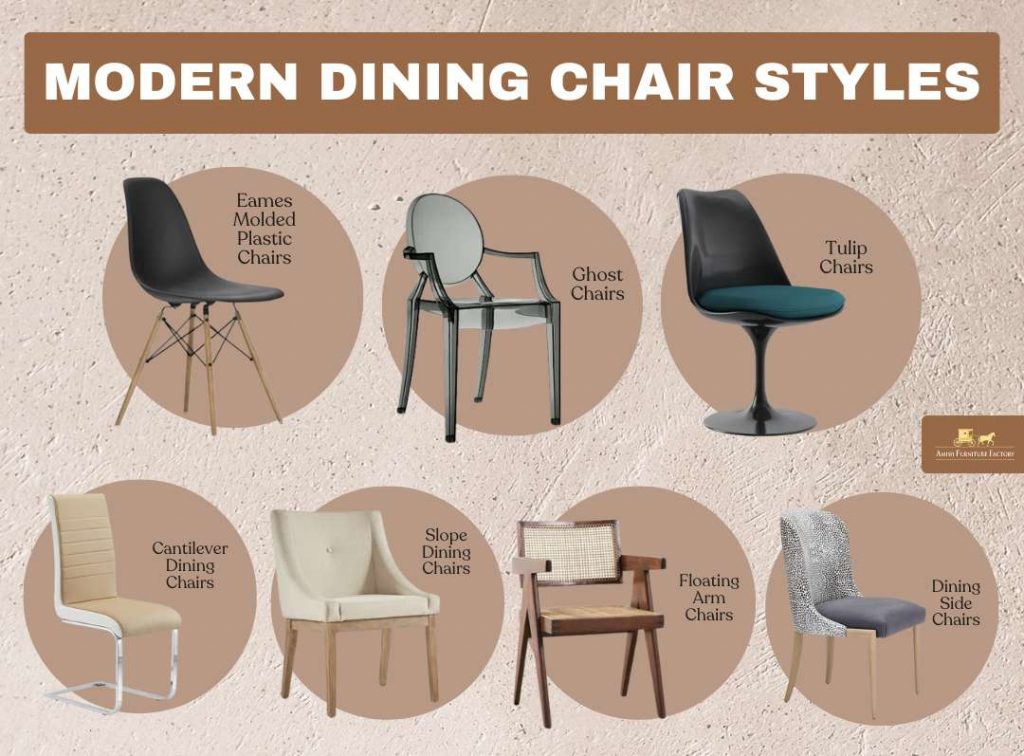
Eames Molded Plastic Chairs
A design icon created by the visionary duo Charles and Ray Eames, these chairs feature a lightweight, molded plastic shell that conforms to the body for surprising comfort. The shell comes in various ergonomic shapes, offering back support. They are typically supported by various leg options, including metal wire Eiffel Tower bases or splayed wooden legs.
Ghost Chairs
These transparent chairs, often made from durable polycarbonate, offer a virtually invisible silhouette. This creates a sense of lightness and openness in the dining room, making them a great choice for small spaces or rooms with limited natural light. Ghost chairs can be found in a variety of styles, from molded plastic to upholstered versions with a transparent seat back.
Tulip Chairs
Named for their distinctive flower-like base, tulip chairs offer a sculptural and elegant look. The original design by architect and furniture designer Eero Saarinen featured a molded fiberglass seat on a cast aluminum tulip base, offering a smooth and seamless look. Modern interpretations may incorporate a variety of materials and finishes.
Cantilever Dining Chairs
These chairs seem to defy gravity, with a seat that cantilevers out from a single support leg anchored to the base. This creates a sleek and modern look, and can be a space-saving option as there are no legs in the way to push in under the table. Cantilever chairs are most commonly made from molded plastic or metal for a lightweight and durable design.
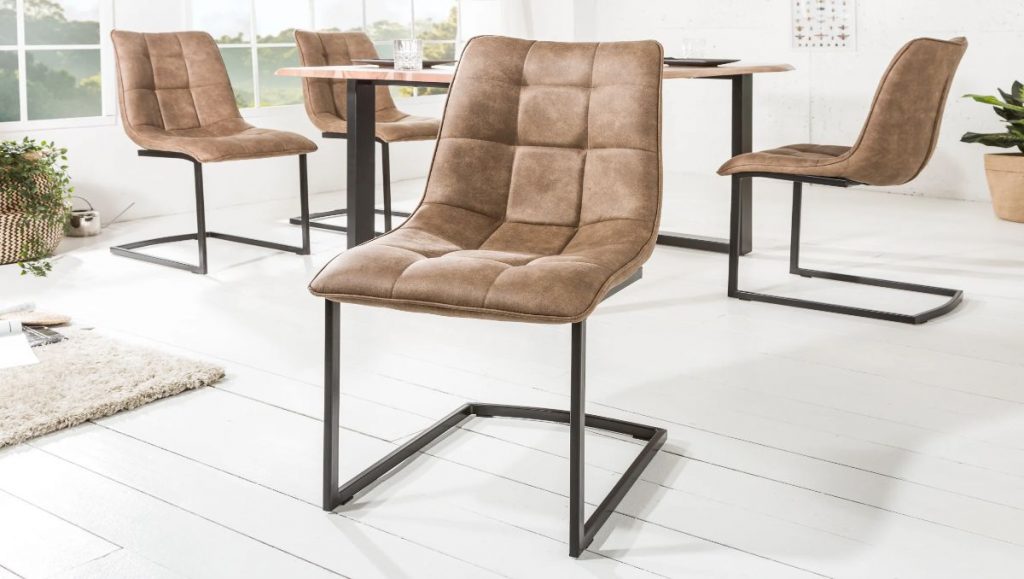
Slope Dining Chairs
Offering a unique and modern silhouette, slope chairs feature a backrest that slopes backward at an angle. This can create a comfortable and visually interesting dining experience, offering good lumbar support while making a statement in your dining room. Slope chairs are typically made from molded plastic or wood for a clean and modern look.
Floating Arm Chairs
These chairs feature armrests that seem to float above the seat, creating a visually striking design element. The space between the armrest and the seat allows for a lighter and more airy feel compared to traditional armchairs. Floating arm chairs can be made from a variety of materials, including wood, metal, or plastic, offering a range of aesthetic possibilities.
Dining Side Chairs
This category encompasses a wide variety of modern dining chair styles that are not armchairs. From minimalist chairs with clean lines and simple silhouettes to sculptural chairs with unique shapes and bold materials, there is a side chair to suit any modern dining space.
You might be interested to learn about counter height vs. bar height seating.
Key Considerations When Choosing Dining Chair Styles
Selecting the perfect dining chairs requires careful consideration of several factors. Here’s a breakdown of the key considerations to guide you in your decision-making process:
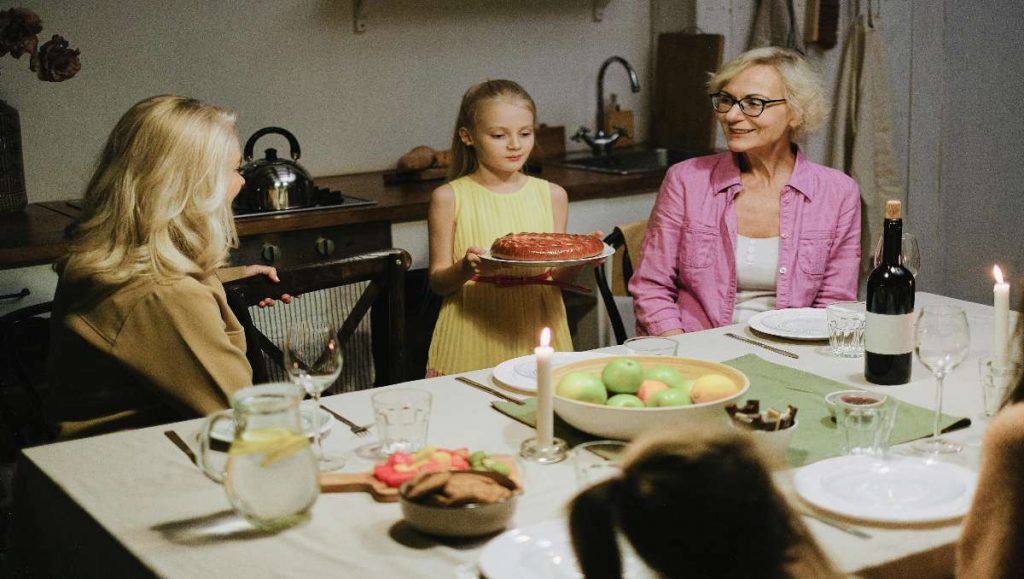
Functionality and Comfort
This means considering the chair’s size in relation to your dining table and the space it occupies. A standard dining table height is around 28-30 inches, and chairs with a seat height of 17-20 inches will provide ample legroom for comfortable dining. Seat depth is also important, with 16-18 inches offering good lower back support.
Aesthetics and Design
The chairs you choose should complement the style of your dining table and the overall aesthetic of your dining room. For instance, a traditional pedestal table pairs well with classic chairs like Chippendale or Queen Anne styles. Modern tables with clean lines look great with minimalist or cantilever chairs.
Budget and Durability
Dining chairs come in a wide range of price points, so it’s important to set a realistic budget upfront and consider how many chairs you need. Material durability is another factor to consider. Upholstered chairs require more maintenance than wooden or metal chairs. Think about your lifestyle and how often you will use the chairs when selecting the material.
Latest Trends and Innovations in Dining Chair Styles
The world of dining chair design is constantly evolving. Here’s a look at some of the exciting advancements shaping the future of dining chairs:
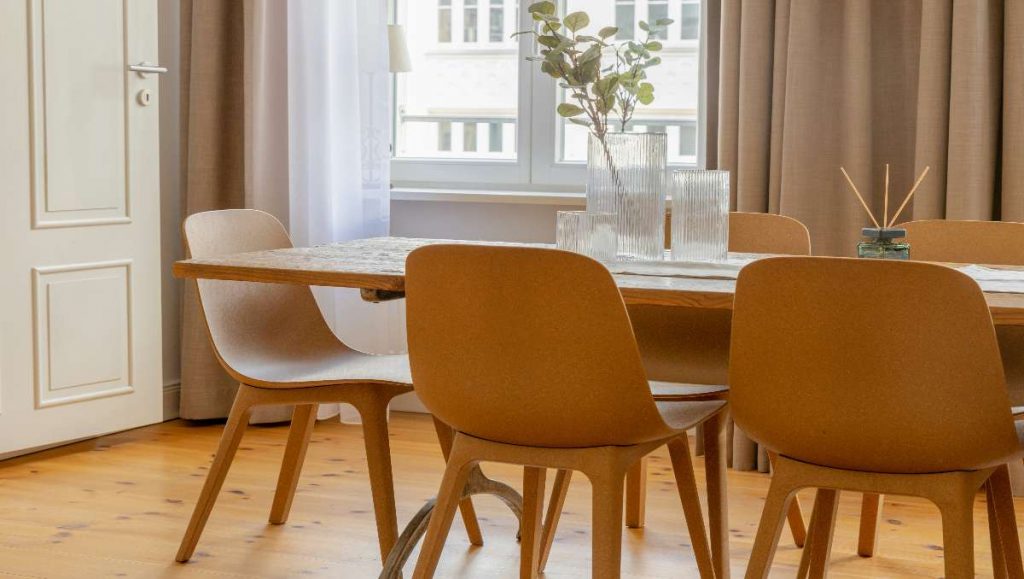
Sustainable and Eco-Friendly Designs: Eco-conscious consumers are driving demand for chairs made from recycled materials like plastic bottles, post-consumer waste, or reclaimed wood. These chairs offer a sustainable option without compromising on style or durability.
Technological Innovations: 3D printing technology is opening up new possibilities for chair design. This allows for the creation of complex and customized shapes, while also reducing waste during the manufacturing process.
Customization and Personalization: Many furniture companies are also now offering made-to-order dining chairs, allowing you to select the size, material, upholstery, and even leg finish to create a chair that is truly one-of-a-kind.
Final Thoughts
The right dining chair style can elevate your dining space from functional to fabulous. Beyond aesthetics, dining chairs play a crucial role in creating a comfortable and inviting atmosphere for shared meals and gatherings. By considering the factors we’ve explored – functionality, comfort, aesthetics, budget, and durability – you can make an informed decision that ensures your dining chairs not only look great but also serve your needs for years to come.
Remember, there’s no single “right” answer when it comes to choosing dining chair styles. The perfect chair for you will depend on your personal preferences, your home decor, and your lifestyle.
FAQs
What is the most popular dining chair style today?
There isn’t a single most popular dining chair style, as trends lean towards personalization and catering to individual tastes. However, some popular choices include modern, Scandinavian, upholstered, and open back. Ultimately, the most popular style is the one that best suits your personal taste and dining space.
How do I choose the right dining chair style for my home?
Consider these factors when choosing dining chair styles: functionality and comfort, aesthetics and design, budget and durability, and personal preferences.
Are modern dining chairs comfortable?
Modern dining chairs can be just as comfortable as traditional styles. Look for chairs with ergonomic features like lumbar support and consider upholstered options for added comfort. Ultimately, comfort is subjective, so try out different chairs before making a decision.
Can traditional dining chairs fit in modern interiors?
Absolutely! The key is to choose traditional chairs with clean lines and a timeless design. Classic Windsor chairs or upholstered armchairs in neutral tones can complement a modern dining space beautifully.
What materials are best for dining chairs?
The best material for dining chairs depends on your needs and preferences. Wood offers warmth, classic style, and durability; upholstery provides comfort and luxury; metal creates a sleek and modern look; and natural materials offer a sustainable and textural element. There’s no single “best” material. Consider the factors mentioned above to choose the material that best suits your needs and style.
